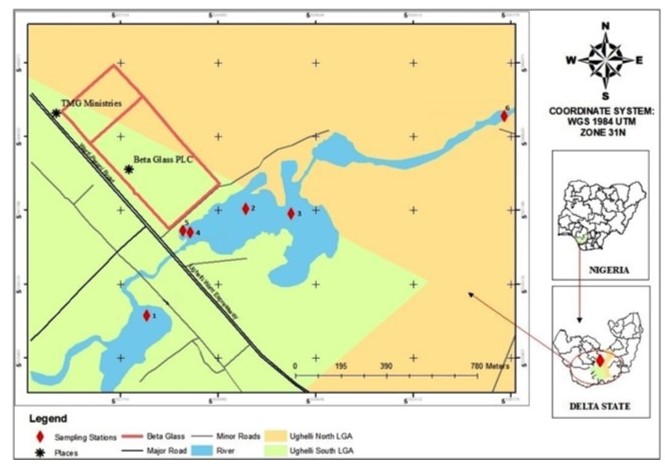Research Article
Barry Okoro*
Barry Okoro*
Corresponding Author
Department of Environmental Management and Toxicology,
College ofScience, Federal University of Petroleum Resources, Effurun, Delta
State, Nigeria.
E-mail: baoken2003@yahoo.com, Tel: +2348068625439
Prekeyi Tawari-Fufeyin
Prekeyi Tawari-Fufeyin
Department of Environmental Management and Toxicology,
College ofScience, Federal University of Petroleum Resources, Effurun, Delta
State, Nigeria.
Abstract
Wastewater from industries in
developing nations are usually discharged into water bodies without adequate
treatment. This study assessed the effect of glass industry wastewater discharge
on the physico-chemical properties of Edor river in Ughelli, Delta State, Nigeria. Water samples were collected
from different sampling stations including surface water and wastewater
discharge outlet. Samples were analysed following standard methods and
procedure. Methods including Winkler’s, open reflux, gravimetric, argentometric,
and Ethylenediaminetetraacetic acid (EDTA) procedures, were employed for specific
measurements like biochemical oxygen demand (BOD), chemical oxygen demand (COD),
total suspended solids (TSS), chloride and hardness respectively. Portable
meters were used for assessing pH, temperature, total dissolved solids (TDS), electrical
conductivity (EC), and turbidity. Additionally, sodium and potassium were measured
using a flame photometer while calcium and magnesium were determined using EDTA
titrimetric method. Colorimetric methods with a UV spectrophotometer were
utilized to determine nitrate, phosphate and sulphate concentrations. Heavy
metals were analyzed using an Atomic Absorption Spectrophotometer (AAS). The
results of the study showed that some parameters of the recipient water, such
as COD (4.33–26.94 mg/L), BOD (1.93–11.96 mg/L), dissolved oxygen (3.73–5.65
mg/L), TDS (27.93–58.44 mg/L), EC (48.68–101.5 µS/cm), total hardness
(25.37–46.65 mg/L), lead (0.003–3.125 mg/L), manganese (0.586–2.864 mg/L),
cadmium (0.021–4.062 mg/L), and chromium (0.311–3.004 mg/L), were impacted by
the wastewater discharge when compared to the control station. The Water
Quality Index (WQI) of the recipient water ranged from 107.64 to 177.20, while
the wastewater sample and control station had 67.07 and 79.00 respectively,
indicating poor water quality that is unsuitable for drinking. Most of the
parameters investigated were within permissible limits for effluents (FEPA) and
surface waters. However, turbidity, total suspended solids, copper, chromium,
and lead exceeded the permissible limits at a few stations. The findings of the
study showed that the river water quality was negatively impacted by industrial
activities in the study area, and this could likely affect inhabitants who
depend on these water resources for survival. Efforts should therefore be made
by factories and government agencies to ensure continuous monitoring and proper
treatment of industrial wastewater before disposal.
Keywords
Wastewater, glass industry, physico-chemical properties, heavy metals, river.
References
1.
Okereke, J. N.; Ogidi. O.I., Obasi, K.O. Environmental and
health impact of industrial wastewater effluents in Nigeria-A Review. Int.
J. Adv. Res. Biol. Sci. 2016, 3(6), 55-67. SOI:
http://s-o-i.org/1.15/ijarbs-2016-3-6-8
2.
Amoatey, P.; Baawain, M.S. Effects of pollution on freshwater
aquatic organisms. Water Environ. Res. 2019,91(10), 1272-87.https://doi.org/10.1002/wer.1221
3.
Zaghloul, K.H.; Mohamed, H.A.; Abdullatef, A.M.; Khalil, M.W.
Genotoxic and Histopathological Effects of Water Pollution on Clarias gariepinus Fish at Fayoum
Governorate, Egypt. Nat. Res. 2020,
18;11(11):499-519. https://doi.org/10.4236/nr.2020.1111029
4.
Onwordi, C.T.; Dan-Sulaiman, S.B. Physico-chemical
characterization and heavy metals of effluents from glass processing plant in
Agbara industrial estate, Ogun, Nigeria. Archives
of Appl. Sci. Res. 2010, 2(1), 212-7.
5.
Singh, K.; John, R.V. Physico-chemical characteristics of
Glass industries waste water in Firozabad district (UP), India. J. Ind. Pollut. Ctrl. 2010, 26(1),39-42. doi 10.18805/IJARe.A-5122
6.
Akharame, M.O.; Ofomata, R.C.; Olorunfemi, D.I.
Physicochemical parameters and heavy metals assessment of effluent discharges
from some industries in Benin City, Nigeria. Afri. Scientist, 2017, 18(3),183-8.
7.
Rathi, P.; Madan, S.Effect of glass industry effluent on seed
germination and biochemical parameters of Glycine max (Soyabean). Indian J. Agri.l Res. 2019, 53(4),
468-72. doi: 10.18805/IJARe.A-5122
8.
Kumar, V.; Chopra, A.; Srivastava, S.; Tomar, V.; Thakur, R.;
Singh, J. Impact of glass industry effluent disposal on soil characteristics in
Haridwar region. India J. Environ. Health,
2016, 2(2), 1-0.doi: 10.15436/2378-6841.16.923
9.
Dirisu, A.R.; Olomukoro, J.O. Investigation of water quality
of two rivers in Agbede-wetlands in Southern Nigeria. Glob. NEST J. 2015, 17(3), 451-62.
10.
American Public Health Association
(APHA).Standard Methods for the
Examination of Water and Wastewater.23rd Edition, American Public Health
Association Washington, 1545pp, 2017.
11.
ASTM International. Annual Book of
ASTM Standards, Water and Environmental Technology v. 11.01, West Conshohocken,
Pennsylvania, pp 6-7. (2003)
12.
Enuneku, A.: Okoh, H.; Oronsaye, C. Assessment of water
quality of Obueyinomo River, Ovia North East Local Government Area, Edo State,
Southern Nigeria. Ethiopian J. Environ.
Studies Mgt. 2017, 10(4), 505-19. doi: https://dx.doi.org/10.4314/ejesm.v10i4.8.
13.
Uwaifo, O.P.; Omogbeme, M.I.; Olomukoro, J.O. Water quality
assessment of Osse River, Gele-gele: a tributary of Benin River, southern
Nigeria. J. Appl. Sci. Environ. Mgt,
2018,22(8),1349-54. doi:10.4314/jasem.v22i8.34
14.
Oboh, I.P.; Agbala, C.S. Water quality assessment of the
Siluko River, Southern Nigeria. Afri. J.
Aqua. Sci. 2017,42(3), 279-86. doi: 10.2989/16085914.2017.1371579.
15.
Federal
Environmental Protection Agency (FEPA). National Environmental protection
(effluent limitation) regulation, 1991.
16.
FME
(Federal Ministry of Environment). Guidelines and Standards for Water Quality
In Nigerian Publication Federal Ministry of Environment, 114 pp, 2011.
17.
Emeka, O.I.; Ekenta, E.O.; Mbanefo, D. Effects of solid
wastes on Ukwaka Stream, Nnewi, Nigeria. Intl.
J. Adv. in Sci. Res. Engr. 2018, 4(5),172-186. doi: 10.31695/IJASRE.2018.32734
18.
Imoobe, T.O.; Koye, P.I. Assessment of the impact of effluent
from a soft drink processing factory on the physico-chemical parameters of
Eruvbi stream Benin City, Nigeria. Bayero
J. Pure Appl. Sci. 2011, 4(1),126-34. doi:10.4314/bajopas.v4i1.28
19.
Olomukoro, J.O.; Egborge, A.B.
Hydrobiological studies on Warri River Nigeria. Part II: seasonal trend in the
physico-chemical limnology. Trop. Freshw.
Biol. 2003, 12, 9-23. doi:10.4314/tfb.v12i1.20872
20.
Ogbeibu, A.E; Oboh, P.A; Tanshi, I. Diurnal
variation and evaluation of physico-chemical properties of the Ikpoba River,
Benin City, Edo state. Trop Freshw Biol,
2012, 21(1),37.doi:10.4314/tfb.v21i1.4
21.
Rim-Rukeh, A.; Agbozu, L.E. Impact of partially treated
sewage effluent on the water quality of recipient Epie Creek Niger Delta,
Nigeria using Malaysian Water Quality Index (WQI). J. Appl. Sci. Environ. Mgt. 2013, 17(1), 5-12.
22.
Abida, B.; Harikrishna, S.; Irfanulla, K. Analysis of heavy
metals in water, sediments and fish samples of Madivala lakes of Bangalore,
Karnataka. Intl. J. ChemTech Res.
2009,1(2),245-9.
23.
Puyate, Y.T.; Rim-Rukeh, A. Some
physico-chemical and biological characteristics of soil and water samples of
part of the Niger Delta area, Nigeria. J.
Appl. Sci. Environ. Mgt. 2008, 12(2). doi:10.4314/jasem.v12i2.55551
24.
Ogbeibu, A.E.; Ezeunara, P.U.Ecological impact of brewery
effluent on the Ikpoba River, Nigeria, using the fish communities as
bio-indicators. J. Aquat. Sci. 2002, 7(1):35-44.doi: 10.4314/jas.v17i1.19908
25.
Zabbey, N.; Hart, A.I. Influence of some
physico-chemical parameters on the composition and distribution of benthic
fauna in Woji Creek, Niger Delta, Nigeria. Glob.
J. Pure Appl. Sci. 2006,12(1):1-5. doi:10.4314/gjpas.v12i1.16541
26.
Bilotta, G.S.; Brazier, R.E. Understanding the influence of
suspended solids on water quality and aquatic biota. Water Res. 2008, 42(12), 2849-61. https://doi.org/10.1016/j.watres.2008.03.018
27.
Hornberger, G.M.; Kelly, M.G.; and Eller, R.M. The
relationship between light and photosynthetic rate in a river community and
implications for water quality modeling. Water Resour. Res., 1976, 12(4), 723-730. https://doi.org/10.1029/WR012i004p00723
28.
Iyama, W.A.; Edori, O.S.; Nwagbara, V.U. Assessment of the
pollution load of the Woji creek water body, Port Harcourt, Rivers State,
South-South, Nigeria. Intl. J. Adv. Res.
Chem. Sci. 2020,7 (1),1-8. doi:
http://dx.doi.org/10.20431/2349-0403.0701001
29.
Beauchamp, R. S. A. Sulphates in African inland waters. Nature, 1953,
171, 769-771.
30.
Ogunfowokan, A.O.; Okoh, E.K.; Adenuga, A.A.; Asubiojo, O.I.
An assessment of the impact of point source pollution from a university sewage
treatment oxidation pond on a receiving stream–a preliminary study. J. Appl. Sci. 2005, 5(1):36-43. doi: 10.3923/jas.2005.36.43
31.
Okeke, P.N.; Adinna, E.N. Water quality study of Ontamiri
river in Owerri, Nigeria. Universal J.
Environ. Res. and Technol. 2013, 3(6):641-9.
32.
Kumar, M.; Puri, A. A review of permissible limits of
drinking water. Indian J. Occup. Environ.
Medicine, 2012, 16(1), 40. doi: 10.4103/0019-5278.99696
33.
Nassef, E. Removal of phosphates from industrial waste water
by chemical precipitation. Engineering Science and Technology, An. Intl. J. 2012, 2(3), 409-413.
34.
Ogbeibu, A.E.; Anagboso, M.U. Baseline
limnological investigation of the Utor River in Esan Southeast, Edo State,
Southern Nigeria: I. Physical and chemical hydrology. Trop. Freshw. Biol. 2006,12, 45-62. doi:10.4314/tfb.v12i1.20875
35.
Imoobe, T.O.; Koye, P.I. Assessment of the
impact of effluent from a soft drink processing factory on the physico-chemical
parameters of Eruvbi stream Benin City, Nigeria. Bayero J. Pure Appl. Sci. 2011, 4(1),126-34.doi:10.4314/tfb.v12i1.20875
36.
Anyanwu E.D. Physico-chemical and some trace metal analysis
of Ogba River, Benin City, Nigeria. Jordan
J. Biol. Sci. 2012, 147(617), 1-7.
37.
Patil, P.N.; Sawant, D.V.; Deshmukh, R.N. Physico-chemical
parameters for testing of water–A review. Intl.
J. Environ. Sci. 2012,3(3),1194-1207.
38.
Mishra, S.; Bharagava, R.N.; More, N., Yadav, A,; Zainith,
S.; Mani, S., Chowdhary, P. Heavy metal contamination: an alarming threat to
environment and human health. Environ.
Biotechnol.: Forsustainable future, 2019,
103-125.https://doi.org/10.1007/978-981-10-7284-0_5
39.
Sankhla, M.S.; Kumari, M.; Nandan, M.; Kumar, R. Agrawal P:
Heavy metals contamination in water and their hazardous effect on human
health-a review. Int. J. Curr. Microbiol.
App. Sci. 2016, 22,
5(10),759-766. http://dx.doi.org/10.20546/ijcmas.2016.510.082
40.
Kumar, V.; Chopra, A.K. Heavy metals accumulation in soil and
agricultural crops grown in the Province of Asahi India Glass Ltd. Haridwar
(Uttarakhand), India, Adv in Crop Sci.
Technol., 2015,4(1),1-6. http://dx.doi.org/10.4172/2329-8863.1000203
41. Papanikolaou, N.C.; Hatzidaki, E.G.; Belivanis, S.; Tzanakakis, G.N.; Tsatsakis, A.M. Lead toxicity update. A brief review. Medical Sci. Montr. 2005,11(10), RA329-336.
42. Akan, J.C.; Abdulrahman, F.I, Sodipo, O.A.; Ochanya, A.E., Askira, Y.K. Heavy metals in sediments from river Ngada, Maiduguri Metropolis, Borno state, Nigeria. J. Environ. Chem. Ecotox. 2010, 2(9), 131-140.
This work is licensed under the
Creative Commons Attribution
4.0
License (CC BY-NC 4.0).
Abstract
Wastewater from industries in
developing nations are usually discharged into water bodies without adequate
treatment. This study assessed the effect of glass industry wastewater discharge
on the physico-chemical properties of Edor river in Ughelli, Delta State, Nigeria. Water samples were collected
from different sampling stations including surface water and wastewater
discharge outlet. Samples were analysed following standard methods and
procedure. Methods including Winkler’s, open reflux, gravimetric, argentometric,
and Ethylenediaminetetraacetic acid (EDTA) procedures, were employed for specific
measurements like biochemical oxygen demand (BOD), chemical oxygen demand (COD),
total suspended solids (TSS), chloride and hardness respectively. Portable
meters were used for assessing pH, temperature, total dissolved solids (TDS), electrical
conductivity (EC), and turbidity. Additionally, sodium and potassium were measured
using a flame photometer while calcium and magnesium were determined using EDTA
titrimetric method. Colorimetric methods with a UV spectrophotometer were
utilized to determine nitrate, phosphate and sulphate concentrations. Heavy
metals were analyzed using an Atomic Absorption Spectrophotometer (AAS). The
results of the study showed that some parameters of the recipient water, such
as COD (4.33–26.94 mg/L), BOD (1.93–11.96 mg/L), dissolved oxygen (3.73–5.65
mg/L), TDS (27.93–58.44 mg/L), EC (48.68–101.5 µS/cm), total hardness
(25.37–46.65 mg/L), lead (0.003–3.125 mg/L), manganese (0.586–2.864 mg/L),
cadmium (0.021–4.062 mg/L), and chromium (0.311–3.004 mg/L), were impacted by
the wastewater discharge when compared to the control station. The Water
Quality Index (WQI) of the recipient water ranged from 107.64 to 177.20, while
the wastewater sample and control station had 67.07 and 79.00 respectively,
indicating poor water quality that is unsuitable for drinking. Most of the
parameters investigated were within permissible limits for effluents (FEPA) and
surface waters. However, turbidity, total suspended solids, copper, chromium,
and lead exceeded the permissible limits at a few stations. The findings of the
study showed that the river water quality was negatively impacted by industrial
activities in the study area, and this could likely affect inhabitants who
depend on these water resources for survival. Efforts should therefore be made
by factories and government agencies to ensure continuous monitoring and proper
treatment of industrial wastewater before disposal.
Abstract Keywords
Wastewater, glass industry, physico-chemical properties, heavy metals, river.
This work is licensed under the
Creative Commons Attribution
4.0
License (CC BY-NC 4.0).

Editor-in-Chief
This work is licensed under the
Creative Commons Attribution 4.0
License.(CC BY-NC 4.0).


